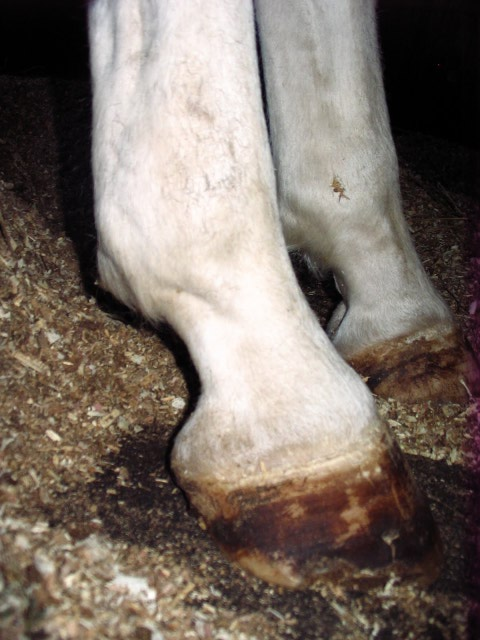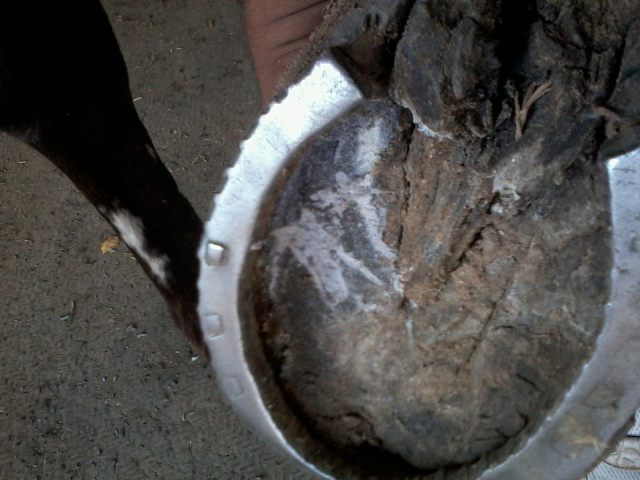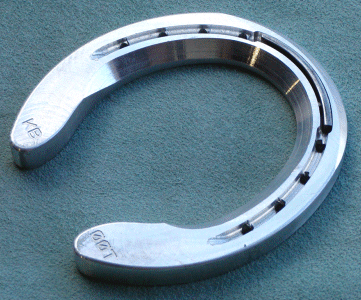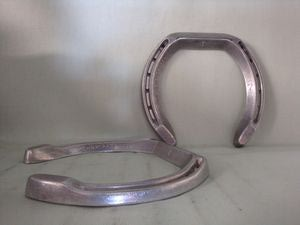QuestionOk here goes,I have my Arabian mare for about 4 years years now and she is about 9 years old.3 months ago however she went lame, our neighbors ( who have about 20 horses) told us she had laminitus!! and we should get her off the pasture. We put her on hay for about a month and she was doing so well we ( not knowing) put her back out on the pasture. 2 weeks later however she was even worse off course, by this time we found out about our BIG mistake never to put her back out. We got her on Bute and she seemed to be improving,we had our ferrier come out and he said she had abscesses in both her front feet and suggested hosing her feet off, soaking her in epsomsalt and iodine, and wrapping her in baby diapers and duct tape, 2x a day which is what we did. she was very sore and to me it looked like he trimmed her a little too short, he also suggested exercising her but that seems almost impossible. Our neighbour suggested soaking boots for her since that seems easier than the diapers, when he came over and looked at her feet he said those are not abscesses at all, its just the soles off her feet that are very soft and leaving open wounds now because off all the soaking. He also said she was trimmed very short, and he didn;t think exercising was a good idea either.So now I put her back in a dirt corral with just hay.
I'm just totally lost, she is still on the Bute, how long does she need that because i also heard that gives stomach ulcers.
Should I soak her ? or not?
Does she need to exercise?
Is the dirt corral ok? I don't have stables?
Oh she is standing up straight and will walk if one off her friends leads.
Thank you soo much for your help.
AnswerHi there. Wow, you must be terribly concerned! I can give you some "general" answers but without seeing your horse's hooves I just cannot give you particulars. That being said, however, yes - dry lot is excellent and that is just what she should be on. 24/7 turnout so she's good there, too. I would spread her hay all over her turnout so she has to walk to get to it and have it there free choice. Turning her out with a buddy will also encourage her to move. You want her to move so the circulation in her hooves will be increased thus carrying more oxygen and nutrients to encourage healthy, new horse growth. It takes approximately 8 months to a year for a hoof to grow down completely from hairline to the ground. Laminitis is inflammation of the laminae - the connective tissue that secures the hoof capsule onto the foot. As the inflammation causes pressure inside the hoof capsule that is unforgiving, other healthy tissue is cut off from the blood circulation thus becoming compromised. Once the hoof is restored to correct balance and levelness with a correct trim, the moving about will, as I said, encourage new growth of the laminae which will strengthen the hoof as it grows down. The use of Old Mac or Epic Hoofboots will help in the comfort and ability of your mare to move around. They can also be used after her recuperation when you are riding on rocky trails and she might be tender. They will help with the protection of the soles.
It sounds as if your horse is struggling metabolically (unable to metabolize carbohydrates and glucoses well) so it *is* wise to keep her off grass from here on in. Feeding her no sugar/low carbohydrates will also aid in stabalizing her metabolism. However, depending on the hay you are feeding - when it was cut, how it was cured and what is used to fertilize, etc - you may be feeding her a high sugar hay which will continue the metabolic issues. There is a website that focuses specifically on this: http://www.safergrass.org You might want to contact the author, Katy Watts, there for more advice as to how to manage your forage issues. Until you can get further information from her or get your hay tested for sugars you can soak the hay before feeding for at least a couple of hours. Putting a few flakes in a laundry basket in a manure tub filled with water works well. Then simply take the laundry basket out of the tub to drain the water and distribute the hay.
As for the Bute - I suggest only a 3 day regime of Bute to give the hooves a bit time to get over the initial, extremely painful, insult. After that I recommend that an herb known as "White Willow Bark" be used in place of the Bute for as long as is needed. Prefereably the WWB should be of Certified Organic origins. White Willow Bark has salicylic properties from which our own aspirin is derived yet holds none of the gut irritating properties in its natural form. It can be used long term without worry of ulcers whereas Bute or other NSAIDs can and do cause ulcers with long term usage.
I would not feed any processed grain to your mare but you can add Beet Pulp as a supplement to the hay. This will also give you a base to add a good, organic vitamin source. Free choice minerals and salts should always be available to her as well.
I wouldn't force her to exercise at this point in time but do allow her to self-exercise with her buddy as she feels up to it. In a few days, maybe 7 - 10 or so depending on her recovery, you could start walking her on a level, firm, solid surface such as a tarred driveway. You may want to put boots on her for this. I would expect to see daily improvements with her. Around the 4 month mark in time I'd expect a tremendous improvement where she is just about "back to normal". But again, keep in mind that 4 months is just maybe 1/2 of her complete hoof growth cycle so you want to make sure she is still being protected. Riding her at that point would still call for hoofboots. But turnout without should be fine.
I hope some of this helps. Please feel free to contact me again if you need some sources for WWB and organic Vitamins.
:) -- Gwen

 club foot
Question
club foot
hello sir, i believe that thi
club foot
Question
club foot
hello sir, i believe that thi
 Barefoot Rehab
QuestionBugsy.jpg
QUESTION: My 13-year-old Appen
Barefoot Rehab
QuestionBugsy.jpg
QUESTION: My 13-year-old Appen
 horrible hooves
Question
left fore right fore
hello sir.
horrible hooves
Question
left fore right fore
hello sir.
 wedge shoes usage
Question
wedge shoe
hello, may i know when to us
wedge shoes usage
Question
wedge shoe
hello, may i know when to us
 what type of shoe
Question
what type of shoe
hello sir, what type
what type of shoe
Question
what type of shoe
hello sir, what type